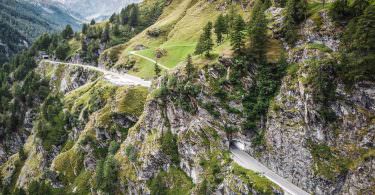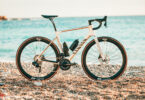Does having WorldTour equipment automatically result in a better time at the Ötztal Cycle Marathon? Do you need to be crazy to enter this event? Does your finishing time even matter? And what’s the point of making plans? Our editor Tobi took on the world’s most legendary mass participation bike event to find the answer to these questions.
238 km and 5,500 metres of climbing – talk to someone that’s not familiar with the Ötztal Cycle Marathon, let alone bikes, and you’ll probably get responses ranging from ‘Wow, how many days will it take you?’ right through to ‘You must be crazy!’ And, well, they’ve got a point. In a certain sense, to line up for the notorious Ötztaler, which starts in Sölden, Austria, you have to be a little bit crazy. But that’s exactly what I am. I’m the sort of person that willingly takes to the roads each day with drop bars and skinny tyres and the sort that records all my rides because #ifitsnotonstravaitdidnthappen.

I’ve also learned over time that not everyone is like me or you. Fortunately, that means that when Trek asked if I wanted to participate in the Ötztaler Cycle Marathon with their full performance setup including a top-of-the-line bike, pre-race coaching, custom insoles, performance analysis and a front-line race start, I had no second thoughts. An opportunity like this would not come around twice, I figured. And, in answer to the question of how many days it would take me to get over the four Alpine passes? One day. Sub-8 hours, that is the plan.



Equipment, training, support – does that make me a pro?
After clocking just under 20,000 kilometres on my bike in 2020, there’s been a noticeable downshift in my yearly total through 2021 that probably has something to do with starting a position at GRAN FONDO at the beginning of this year. But I know that virtually anyone can get around a sportive course, right? It’s just a question of how long it takes. The last rider to cross the line takes around double the time of the winner. We’re talking seven hours versus thirteen. The ones finishing in double figures tend to be the weekend warriors, the newbies, and the workaholics. But there are many, many reasons why some are slower than others – and some even ride slowly on purpose so that they can soak up the atmosphere. Up at the front, it’s a different story: winning the Ötztaler requires the commitment of a pro.

Anyone can ride the Ötztaler but not everyone can do it in a day …
I put myself between the two extremes. When it comes to equipment and support, Trek’s contribution has put me closer towards the pro end of the spectrum with the loan of an Émonda SLR 9 eTap, which we recently had on test. In the two months leading up to the event, I’ve had each training ride dissected and built upon by the performance experts at TRAINALYZED, who are the team supporting the TREK VAUDE mountain bike team. To ensure the ultimate power transfer, Winsole provided me (along with a lot of pro riders) with custom carbon insoles that promise optimal arch support. I wonder what difference this will make to my riding other than instilling me with a sense of dread that I can no longer cry ‘equipment’ or ‘training’ as an excuse for a poor performance.

Trek Émonda SLR 9 eTap Project One
€ 14,299
Specifications
Seatpost Bontrager Carbon Seat Mast Cap, long individual 20 mm
Brakes SRAM RED eTap AXS HRD 160/160 mm
Drivetrain SRAM RED eTap AXS 2 x 12
Chainring 48/35
Stem Bontrager Aeolus RSL 100 mm
Handlebar Bontrager Aeolus RSL 420 mm
Wheelset Bontrager Aelous RSL 37 12 x 100/12 x 142 mm Thru Axle
Technical Data
Size 47 50 52 54 56 58 60 62
Weight 6.86 kg
Specific Features
one-piece Bontrager Aeolus RSL cockpit
dual-sided power meter
integrated seat mast
Bontrager DuoTrap sensor compatible


A bad omen
Ahead of the Ötztal Cycle Marathon, I was busy weighing up my lofty dream of going sub-8 hours with my pro level setup. When Friday 13th rolled around and a black cat in the form of an innocent-looking Fiat 500 shot out from the right and introduced me to its bonnet, I was even less convinced. The impact was nominal but the Trek Émonda felt every bristle of its fur. It was a write-off. There were two weeks left until the event.
Fortunately, the team at Ridelust sent over a replacement Émonda SLR 9 eTap, but I didn’t get in the saddle of that bike until race day. The thought of chasing 100 km/h down the Kühtai and Timmelsjoch on an unfamiliar bike, let alone embarking on the initial descent in full-on race fever down to Ötz, made me – even with the experience of test riding hundreds of bikes and changing two wheels more often than I change my bedsheets – a little apprehensive. The sub-8-hour goal was beginning to feel even further out of reach.

Then came news of a landslide on the Kühtai with a diversion that added distance and climbing. This re-routing would mean that the Ötztaler, for once, would match its much-hyped 238 km and 5,500 metres of climbing that bike riders have notoriously undermeasured year after year, over four Alpine passes – the Kühtai, Brenner, Jaufenpass and Timmelsjoch in that order. But here I was on the eve of the event with an unfamiliar bike, an extended route and a weather forecast that was enough to bring me out in a fit of shivers in my hotel room. That was it: my 8-hour target was over before it had even begun. The new plan was to stick to a pace and power number I know I can hold and not to take risks on the downhills.
The man with the hammer
What percentage of my FTP did I use on the climbs, how many calories did I consume, did I implement a hydration strategy? Who cares. I’ll spare you the details. Each race is different. We’re all individuals. If you’ve got a race strategy, it needs to be tailored to you and your ability. Plus, flexibility and a willingness to adapt to the day’s conditions and whatever unscripted lines are thrown at you by fate. Your dreams or your race plan can be ripped up within seconds. It might not take a landslide like it did in my case; it could be down to a little mishap, a puncture, or simply going off too hard on the first climb. By the time you reach the Timmelsjoch, you may have little left in reserve.



Feeling like God on the Kühtai but a fallen angel on the Timmelsjoch
After the starting gun in Sölden, the Ötztaler doesn’t really take off until the Jaufenpass, so go easy until then. Even on the long and rather flat climb of the Brenner, it’s best to sit in and get pulled along because the man with the hammer always comes. If you can keep him at bay until the Timmelsjoch, you’ll be in a good position. The closing stages of an event like this come down to what’s in your head rather than in your legs. Can you push past the searing pain in your muscles? Can you silence the panic and rise above the thoughts of easing back or even stepping off as you battle on towards the highest point of the Ötztaler? The final descent to Sölden is a hit of serotonin and redemption after all that suffering. It feels damn good.

It is more about how you deal with the setbacks than reaching the goal
I crossed the line 8 hours and 55 minutes after I started. The plan of going sub-8-hours remains exactly that: a plan. But whatever the outcome, if you know you have given everything you have on the day then you can be proud. Many people try their best at the Ötztaler and still don’t finish – and that’s okay. It isn’t about the finish line, it’s the journey you’ve been on: the training, the tinkering with your bike, the hours you’ve spent in the saddle with friends, the endorphins from riding, the effect on your mental and physical health … the list goes on. When plans don’t pan out and you don’t reach your goal – sporting or otherwise – there’s a window for you to analyse what went wrong and where, and set new goals. Being ambitious pays off. Asking yourself if you have more to give is a good thing, trust me. Then, one day, when you cross another finish line, sign off a massive deal or get a promotion, you will realise just how much that determination has paid off.
Ötztal Cycle Marathon – agreeably crazy
The buildup to an event as mythical as the Ötztaler often sees a cyclist lost in intricacies of performance – of whether something will enhance or impede your ride, how hard to push, and how you’ll work your pacing strategy. But none of these doubts can be resolved until the first pedal strokes. In cycling – as in life – you can only plan so much and dreams can be crushed in an instant. If that happens, you still have the opportunity to look up. The scenery is still breathtaking. The pain in your legs is still real. And the story you take home will probably be even better. Does that make us crazy? Probably.

Did you enjoy this article? If so, we would be stoked if you decide to support us with a monthly contribution. By becoming a supporter of GRAN FONDO, you will help secure a sustainable future for high-quality cycling journalism. Click here to learn more.
Words: Photos: Ötztal Tourismus/Sportograf

















